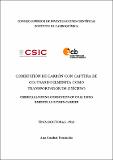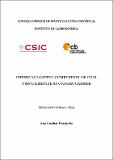Por favor, use este identificador para citar o enlazar a este item:
http://hdl.handle.net/10261/48592COMPARTIR / EXPORTAR:
 SHARE
BASE SHARE
BASE
|
|
| Visualizar otros formatos: MARC | Dublin Core | RDF | ORE | MODS | METS | DIDL | DATACITE | |

| Título: | Combustión de carbón con captura de CO2 usando ilmenita como transportador de oxígeno |
Otros títulos: | Chemical looping combustion of coal using ilmenite as oxygen carrier | Autor: | Cuadrat, Ana CSIC | Director: | Adánez Elorza, Juan CSIC ORCID; Abad Secades, Alberto CSIC ORCID | Palabras clave: | Captura de CO2 Transportador de oxígeno Carbón Combustión CO2 capture Chemical looping combustion Coal Combustion |
Fecha de publicación: | ene-2012 | Editor: | Universidad de Zaragoza CSIC - Instituto de Carboquímica (ICB) |
Resumen: | Chemical-Looping Combustion, CLC, is a promising combustion technology with inherent capture of the greenhouse gas CO2 at low cost for fossil-fuelled power units. In CLC the oxygen from air is transferred to the fuel by a solid oxygen-carrier that circulates between two interconnected fluidized-bed reactors: the fuel- and the air-reactor. The direct contact between air and fuel is avoided and CO2 is obtained in a separate stream. In-situ gasification Chemical-Looping Combustion, iG-CLC is an option of using CLC with solid fuels where coal gasification takes place in the fuel-reactor and the oxygen-carrier oxidizes the products of fuel gasification and devolatilization. The oxygen-carrier is led to the air-reactor where it is re-oxidized by air. This study is focused on the development of iG-CLC, using ilmenite, a low cost mineral composed of FeTiO3, as oxygen-carrier. The performance of ilmenite was studied from the smaller to larger scale. The reactivity of ilmenite with CH4, H2 and CO as main products of coal devolatilization and gasification under different operating conditions of temperature and gas concentration was analyzed in TGA and a batch fluidized bed reactor. Initially ilmenite presents a rather low reactivity, but it undergoes an activation process in its reaction rate, whose final value is adequate for its use in iG-CLC, as well as its oxygen transport capacity. The reaction kinetics of ilmenite for the main reduction and oxidation reactions were determined. No agglomeration problems and adequate fluid dynamic behavior and attrition rates were found after many redox cycles. The char gasification process was evaluated in batch fluidized bed reactor at different temperatures and H2O-CO2 mixtures as gasification agents. The gasification rate increases in presence of the oxygen-carrier. The feasibility and process performance of iG-CLC were studied in continuous testing with coals of different rank from lignite to anthracite in a 500 and a 10 kWth facilities. The effect of several operation parameters was analyzed: the fuel-reactor temperature, the coal particle size, the solids recirculation rate, the coal feeding flow, and the flow and type of gasification agent. The unburnt gases were found to come from the volatile matter. Higher carbon captures are obtained with coals of lower rank which are more reactive and gasify faster. Using H2O as gasifying agent is desirable to enhance char conversion in case of most coal types. Using some CO2 is admissible, depending on the resulting gasification rate with CO2 with the fuel used. Big differences in carbon capture were found depending on the coal. At 900ºC, with a mean solids residence time of 14.4 minutes and steam as gasification agent, the CO2 captures were 90% for lignite, 48% for high volatile bituminous coal, 54% for medium volatile bituminous coal and 29% for anthracite. The combustion efficiencies in the fuel-reactor were always above 70%. For all types of solid fuels the CO2 capture and combustion efficiency can be increased when working at high temperatures, high inventories and adapting the solids circulation rate to increase the residence time in the fuel-reactor. To optimize the process, a simplified model based on mass balances and kinetics of the reactions was developed. It allowed to know that 1000-2000 kg/MWth of inventory are needed in this technology, that full combustion can be reached if the contact of the volatiles in the fuel reactor was improved and that an optimized iG-CLC process with a highly efficient carbon separation system could achieve CO2 captures above 90%. The good results confirm that iG-CLC is an adequate process to burn solid fuels with CO2 capture. | Descripción: | 154 páginas.-- Tesis doctoral leída en el Departamento de Ingeniería Química y Tecnologías del Medio Ambiente de la Universidad de Zaragoza. | URI: | http://hdl.handle.net/10261/48592 |
| Aparece en las colecciones: | (ICB) Tesis |
Ficheros en este ítem:
| Fichero | Descripción | Tamaño | Formato | |
|---|---|---|---|---|
| Tesis-Cuadrat-(ESP).pdf | Tesis en español | 2,47 MB | Adobe PDF |  Visualizar/Abrir |
| Tesis-Cuadrat_PhD-(ENG).pdf | PhD thesis in English | 2,32 MB | Adobe PDF |  Visualizar/Abrir |
CORE Recommender
Page view(s)
506
checked on 15-abr-2024
Download(s)
1.547
checked on 15-abr-2024
Google ScholarTM
Check
NOTA: Los ítems de Digital.CSIC están protegidos por copyright, con todos los derechos reservados, a menos que se indique lo contrario.
